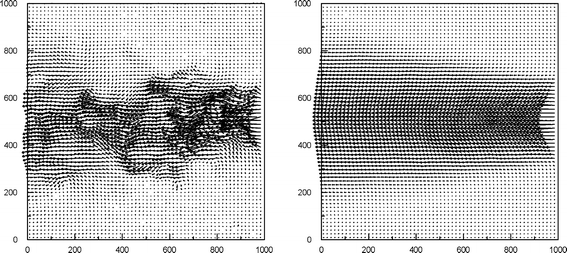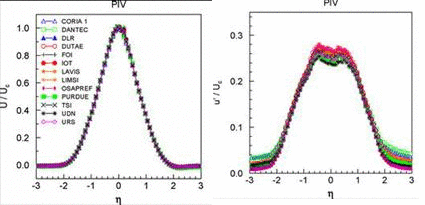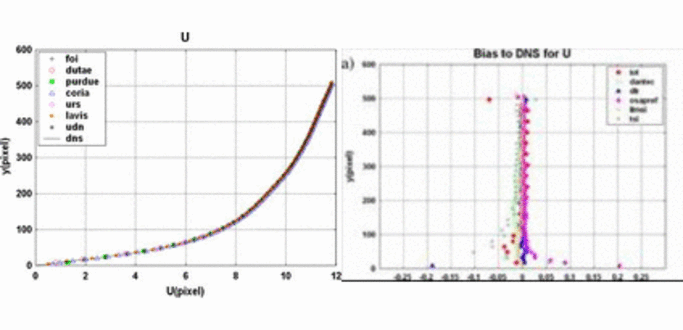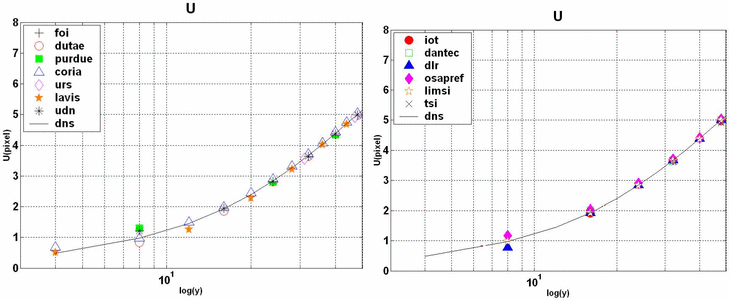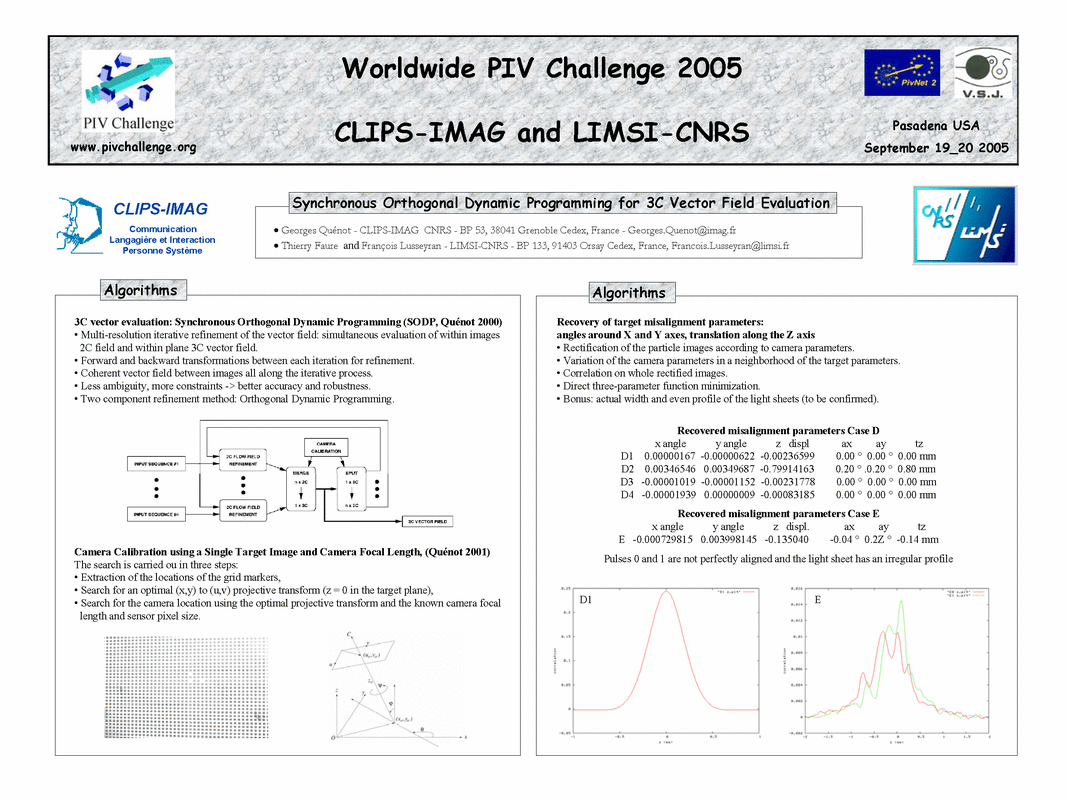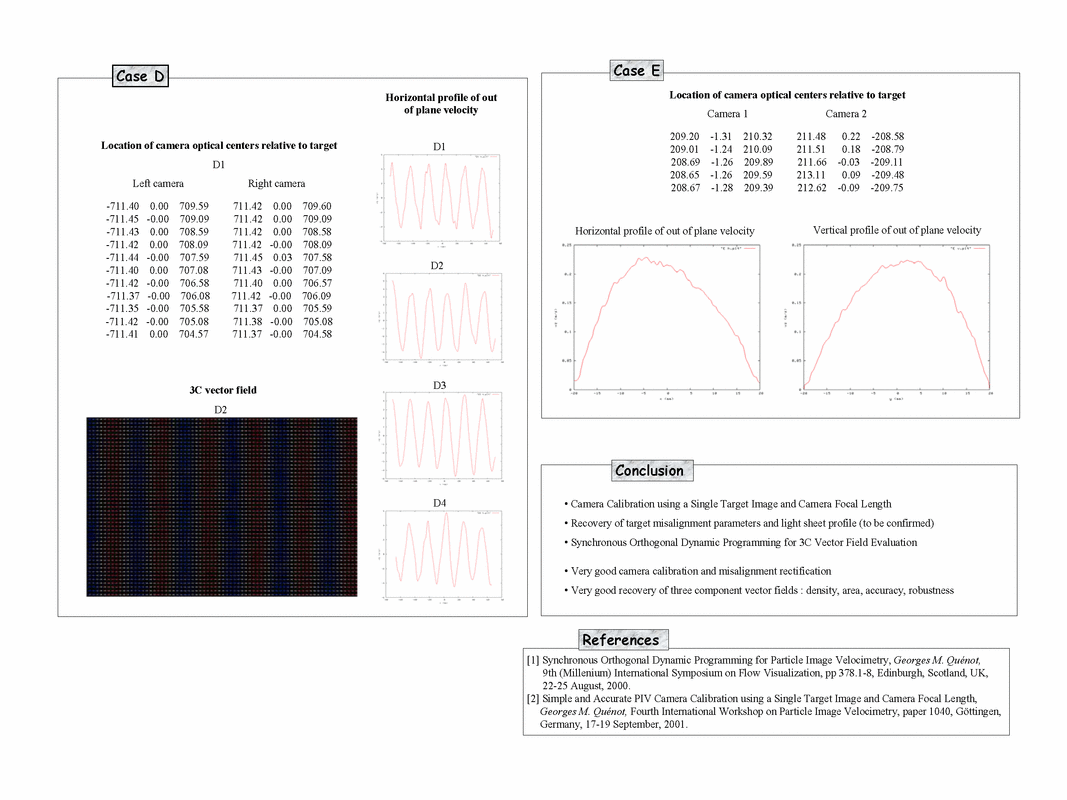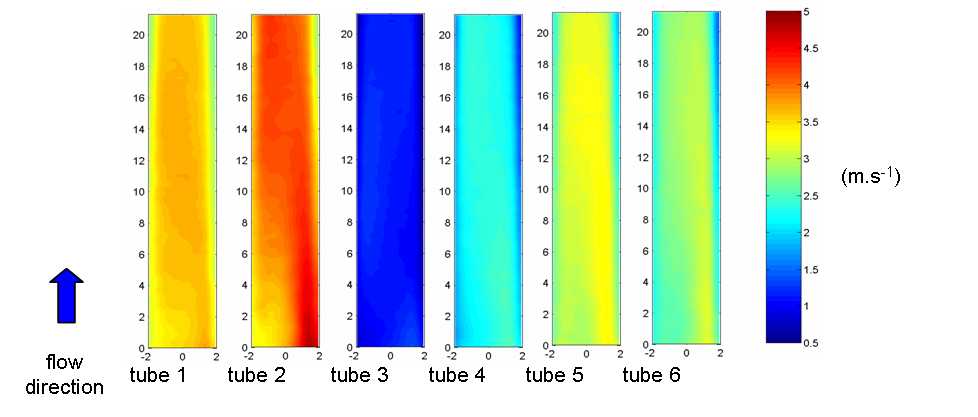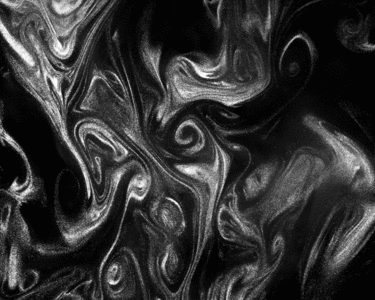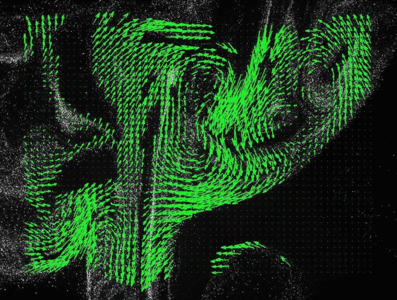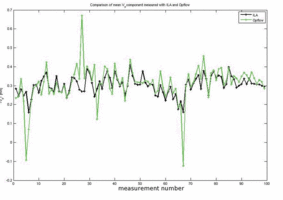Particle Image Velocimetry Improvement through optical flow
F. Lusseyran, T. Faure in collaboration with G. Quénot (IMAG, Grenoble)
Contents |
Object
The objective of this research thematic is to enhance Particle Image Velocimetry (PIV) using an optical flow approach (algorithm “opflow”), with dynamical programming, developed earlier by George Quénot within a collaboration between the Human-Machine Communication department and the Mechanical-Chemistry department of the LIMSI.
Description
- An important stage of validation of the algorithm has been obtained during the last four years. As part of the 2nd International PIV Challenge 2003 (http://www.pivchallenge.org/) we have demonstrated that this method allows a very precise measurement in the zones of strong velocity gradient in particular in the vicinity of the wall (see below). With the participation in the 3rd International PIV Challenge 2005, we test the ability of “opflow” to measure the third component of the velocity field and to be apply on images acquired by hi speed cameras.
- The algorithm “opflow” has been tested and applied on:
- external aerodynamics in automobile: by validating the PIV methods for the so called “large velocity fields”, so as to access to the velocity field in a recirculation area behind a scale-one vehicle. This study was undertaken in collaboration with three other teams (CLIPS-IMAG Grenoble, CORIA Rouen, R&D Vision), within the framework of the CNRT-R2A “Aérodynamique et Acoustique des Véhicules Terrestres”.
- 3D flow inside a heat exchanger, in the frame of collaboration with F. Launay at IPN Orsay (IPHI).
- Investigations of turbulence statistics in the laboratory model of an atmospheric cloud (collaboration with P. M. Korczyk, T. A. Kowalewski, IPPT-PAN, Warszawa, Poland)
Results and prospects
Opflow Validations
- Main results from the 2nd International PIV Challenge 2003 [3]
Sixteen teams from all over the world were engaged in the challenge. Three kinds of images sets constituted the basis of the test (quote cases A to C).
The purpose of case A was to start imperfect experimental PIV images, (as opposed to idealized synthetic PIV images), of a turbulent flow – fade with no non-dispersed tracer particles, unlighted by non identical laser pulses, etc – and to test the performances of different algorithms. A self-similar turbulent jet was chosen, for which the turbulence statistics are well known (Figure 1 ). This is a challenging test case, as the observed flow contains both regions of high velocity and high turbulence intensity (near the jet centreline) and regions of low velocity and a laminar flow state (in the outer flow region). All algorithms catch the mean profile well; a dispersion of the results appears in the fluctuations profiles. Concerning the “pick-locking”, the optical flow algorithm is in good position, for structural reasons (Figure 2).
Images for case B were generated from a high resolution (576×576×148) DNS of a turbulent open channel flow provided by Prof. Tsubokura of the Tokyo Electro-communication University. The Reynolds number based on the channel half-width and the wall friction velocity was Reτ (= huτ/ν) = 640. To compute the flow, the chosen parameters allow that one pixel corresponds to 0.195 wall units, which would be a fairly good spatial resolution for a PIV experiment in such a configuration (Figure 3 and Figure 4).
The case C was built to assess the performance and accuracy of state-of-the-art time-resolved PIV systems, i.e. rapid images acquisition.
The case C was built to assess the performance and accuracy of state-of-the-art time-resolved PIV systems, i.e. rapid images acquisition.
- Main results of the 3rd International PIV Challenge (2005)
This challenge is devoted to the validation of the stereoscopic PIV for the measurement of the three velocity components in a plane, and to the validation of time-resolved PIV. The method proposed consists in a blind test of five sets of images, noted from A to E, in order to compare the precision and the robustness of various algorithms developed by the whole international PIV community. Two types of images are distinguished: • synthesized images obtained numerically from a field of known displacements, and which allow a quantitative error evaluation, • photographic images of a real seeded flow, which include natural noise not easily imitable. Set A, aims to test the space resolution starting from synthesized images; set B allows to evaluate processing images series resolved in time, i.e. synthetic images series with regular times intervals short enough to respect the Shannon's criterion; set C has the same objective as B but starting from real images of a turbulent jet flow; set D, allows the measurement of the precision of the stereoscopic algorithms and of the calibration, starting from synthesized images; set E, has the same objective that D but starting from real images of a pipe flow. Our treatments carried out in collaboration with George Quenot (CLIP-IMAG Grenoble, France) were submitted to the committee of the challenge. Results will be known after the publication of the meeting hold in Pasadena (Ca, USA), 19-20 September 2005.
Opflow enhancements and applications
- Large field PIV:
In the domain of large velocity field (~ 2m x 2m) the application of the existing hardware and algorithms is not straightforward. This is a challenging issue for unsteady flow diagnostics to application at the external hydrodynamics in car industry. From the conclusion of this study it can be given that: from images analyzing point of view, the use of advanced algorithms allows to appreciably improve quality of the velocity measurement by PIV under “large field” conditions. One can hope then to find the same precision for a 2000 x 2000 mm² field as for a 400 x 400 mm² field. The feasibility and interest of the application of the PIV in a wind tunnel of great dimension were highlighted within the framework of this project. No scientific and technical bottle neck is appeared, neither on the level of the material, nor on the level of the treatment algorithms.
- Heat exchanger qualification (collaboration with F. Launay of IPN Orsay)
The aim is to investigate experimentally and numerically the 3D flows inside a heat exchanger in the development of the Radio Frequency Quadrupole (RFQ) for the “High Intensity Proton Injector” (IPHI). We took advantage of the high spatial resolution of optical flow algorithm to measure velocity field inside small glass pipes (4 mm in diameter) of a scale-one heat exchanger with many bifurcations. One gets the velocity distribution between each of the six ducts (Faure et al. 2006, 2004, 2003, Launay et al. 2005, 2004). Figure 5 shows the large scatter of the velocity distribution between the tubes.
- Hi speed PIV in 3D flow :Investigations of turbulence statistics in the laboratory model of an atmospheric cloud (collaboration with P. M. Korczyk, T. A. Kowalewski, IPPT-PAN, Warszawa, Poland)
Interaction between small-scale turbulence and cloud particles is a key issue in warm rain formation mechanism, which is an important meteorological and climatological challenge. We investigate this interaction observing motion of cloud droplets in a glass walled chamber 1m deep, 1m wide and 1.8m high, described elsewhere . Cloudy air containing water droplets enters the main chamber forming the negatively buoyant, turbulent plume, mixing with unsaturated air in the main chamber and producing additional turbulence by evaporative cooling of droplets (figure 6 left). The plume is illuminated with a 1.2mm thick sheet of laser light, forming the vertical cross-section through the central part of the chamber (figure 7 left). Images of flow are recorded by a high-resolution CCD cameras placed outside the chamber. Long sequences of images are collected to evaluate small scale turbulence statistics of the flow. The spatial flow characteristics are obtained using two- and three-component (Stereo-PIV) setup and double pulsed 35mJ Nd:YAG laser. The setup permits to record only few image pairs per second. ThereforeBut, for temporal turbulence statistics, it is enough to acquire long sequences of images (1000 and more) are acquired using high-speed CCD camera (PCO1200HS) and CW 5W Argon laser for illumination. Droplets visualized in the chamber differ from typical PIV images with uniformly distributed tracers. Chaotic dynamics of mixing observed in the experiments makes images of flow complex and not easy to process. Therefore, standard PIV algorithms have to be used with care to avoid artefacts in the velocity field. Four different PIV evaluation methods are applied and tested on our experimental data: ILA OFS PIV algorithm , two in house developed multi-scale dynamic widow and image deformation based PIV codes, and Optical Flow evaluation method . Statistical quantities and decompositions of vector fields are evaluated to check advantages of different evaluation methods. It was found that image deformation approach and in some sense equivalent Optical Flow methodology are the most reliable for our purpose (figure 6 right).
| Figure 6. image of the flow seeded by fog (left) and computed velocity field in the seeded area (right) [Korczyk et al. 2006]. | |
| Figure 7. Experimental setup (left) and velocity profiles comparison (right)[Korczyk et al. 2006]. | |
References
LUSSEYRAN, F., QUÉNOT, G. (2003) Second International PIV Challenge, Busan (Korea), September 19-20, 2003.
QUÉNOT, G., LUSSEYRAN, F. (2005) PIV Challenge 2005, Pasadena (Ca, USA), September 19-20, 2005.
STANISLAS, M., OKAMOTO K., KAEHLER, C. AND WESTERVEEL (2005) Main results of the Second International PIV Challenge, Experiments in Fluids, vol. 39, no.2, pp. 170-191.
HONORÉ, D., LECORDIER, B., TRINITÉ, M., LUSSEYRAN, F., FAURE, Th., SUSSET, A., QUÉNOT, G. (2005) PLIV : Particle Large Image Velocimetry – Développement de méthodes de traitement avancées adaptées à la réalisation de mesures PIV grand champ, Rapport final, contrat CNRT / 2004 / 061, Juillet 2005.
FAURE, Th. M., LUSSEYRAN, F., GOUGAT, P., LAUNAY, F. (2006) Experimental investigation of the flow distribution inside a tubular heat exchanger, Journal of Fluids Engineering, vol. 128, n°6, pp. 1218-1227
FAURE, Th., SATO, M., LECOCQ, Y. (2003) Mesures PIV par flot optique dans deux types d’écoulements turbulents, Rapport interne LIMSI-CNRS 2003-17.
FAURE, Th., LUSSEYRAN, F., GOUGAT, P., LAUNAY, F. (2004) Exploration de l’écoulement dans un échangeur de chaleur tubulaire par vélocimétrie par images de particules, 9ème Congrès Francophone de Vélocimétrie Laser, Bruxelles (Belgique), 14-17 Septembre 2004, pp. K.4.1-K.4.8.
LAUNAY F., FAURE Th., LUSSEYRAN F., GOUGAT P. (2004) Ecoulement 3D dans une structure d'échangeur Confrontation Mesures Simulations, HAL, democrite-00023371.
LAUNAY, F., FAURE, Th., LUSSEYRAN, F., GOUGAT, P. (2005) Investigations expérimentales et numériques d’un écoulement tridimensionnel dans une structure d’échangeur thermique pour le RQF d’IPHI, Journées Accélérateurs de la SFP, Roscoff (France), 10-12 Octobre 2005.
KORCZYK, P. M., LUSSEYRAN, F., KOWALEWSKI, T. A., MALINOWSKI, Sz. P. (2006) Investigations of turbulence statistics in the laboratory model of an atmospheric cloud, EUROMECH Fluid Mechanics Conference 6 (EFMC 6), Stockholm, June 26-30, 2006
